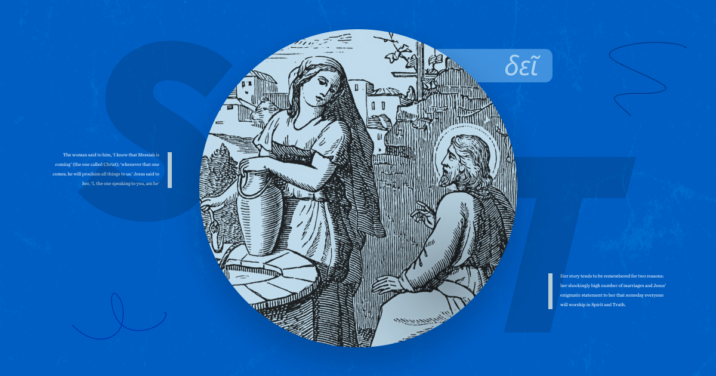Saint Photini, so named in the Orthodox tradition, was an especially blessed woman. You may know her simply as “the woman at the well” from John 4. Her story tends to be remembered for two reasons: her shockingly high number of marriages, and Jesus’ enigmatic statement to her that someday everyone will worship “in spirit and truth” (John 4:24).
This well-known statement about worship raises many deep theological questions. It is tempting to gloss over the rest of Photini’s story to focus only on the question of what type of worship Jesus was talking about. But the full meaning of his statement can only be understood within the context in which it was spoken, within the wider context of John’s Gospel, and within the wider biblical context. When we read the statement in these contexts, I propose that it leads us to acknowledge that God has always required people to worship him with their spirit and in truth, and that this new way of worshipping in spirit and truth is a revelation of the then-yet-to-be revealed Holy Spirit of Truth.
St. Photini
Jesus orchestrated his meeting with Photini. He chose the travel route. He sent the disciples on an errand into town. And the conversation between Jesus and this “woman at the well” is a great case study in Jesus’ penchant for talking over people’s heads—for talking about something spiritual while the other party was still thinking on the physical level. For the first half of their conversation, the woman thought he was talking about literal water. But Jesus, almost immediately, had begun to talk about spiritual water. Photini missed his jump from the physical to the spiritual. I would have, too; as would have you. Nicodemus, in the previous chapter, missed a similar jump.
As their conversation progressed, and as this Samaritan woman continued to miss the spiritual meaning of Jesus’ words, he gave her a little push: he asked about her husband. The traditional reading of this question says that Jesus is pointing out her sin and that her subsequent question about worship (v. 19) is an attempt to distract Jesus from her sin. Such an interpretation is understandable when readers are unfamiliar with her world—a world in which death often occurred early and frequently, in which men could divorce their wives for any reason but women could not do the same, in which women relied on their families to arrange their marriages, and in which women had little chance of economic independence. But understanding those cultural–historical concepts opens up other possible ways of seeing Photini’s story. Perhaps she had been widowed five times. (It was actually common to be widowed two to three times.) Maybe there were some divorces, but maybe they occurred because of her husband’s sin and not hers. And as for her sixth non-husband partner, maybe her family arranged an unofficial marriage with a Roman citizen: unofficial because Roman law forbid marriages with non-citizens. Or perhaps because the end of her last marriage left her economically destitute, she had no choice but to become a second wife (an unofficial marriage) in order to merely survive. We simply do not know.1
The literary context also raises questions about the traditional reading. If Jesus’ intent was to convict her of sin, why does he let her change the topic? Why does he never tell her to “go and sin no more”? If her question on worship was merely a distraction technique to hide her sin, why does Jesus not redirect her back to her sin? If her question was a distraction technique, then it worked.
Regardless of what led to the end of her five marriages, after this Photini finally realized that Jesus was talking on the spiritual level. I propose that Jesus’ question was presented to help her see the spiritual side of his words. Because this strange man sitting by the well knew things about her grief-filled life that no one could have possibly guessed, Photini finally recognized that he was no mere man—he was a prophet. (Later she realizes that he is much more than a prophet; he is the Messiah.) Believing that she was talking with a man who spoke truths on behalf of God, she reached deep inside and brought out her most burning question: she asked this man where people should worship. In spite of—or perhaps because of—her suffering, she cared deeply about worshiping God well.
Physical vs. spiritual
Photini’s question about where people should worship God is not as simple as it may first appear. Though it is a binary question—Mount Gerizim (the Samaritan answer) or Jerusalem (the Jewish one)—it is about necessity and not preference. As a Samaritan, she had been taught to worship on Mt. Gerizim, but she was aware that the Jewish community said worship must (δεῖ) occur in Jerusalem (v. 20). She wanted to know whether she (and her community) were wrong to worship on Mt. Gerizim. She wanted to know the right way to worship the God she served.
Instead of automatically assuming her people were correct, she questioned the truth of what she was taught. Before her sat a Jewish prophet who had come to Samaria. Perhaps he had come to tell them to worship in Jerusalem. Or maybe he had come to worship at Mt. Gerizim. Or perhaps he was there for some other reason. Whatever the reason, this prophet could help her worship rightly. He would be able to direct her to the location where God wanted her and her community to worship.
Jesus, though, never truly answered her question. He began by pointing to a future time where the location of human worship will not matter (John 4:21). Then his response in 4:22 suggests that since the Jews worship what they know, Jerusalem is the correct location. Still, Jesus never condemns Samaritan worship on Mt. Gerizim.
The refusal to directly pick Jerusalem over Gerizim, the absence of a condemnation against worship at Gerizim, and the discussion of worship in spirit and truth is not a divine slight against the physical aspects of worship. Rather, Jesus reorients the focus from the physical to the spiritual—while, also, not discounting the physical.
“In Spirit” or “in spirit”?
It is in his response to Photini’s question of location that Jesus utters the famous statement,
An hour is coming—and now is here—when the true worshipers will worship the Father in spirit and truth, for indeed the Father seeks such people to be his worshipers. (John 4:23 LEB)
Here, English translations have a difficult choice to make, and there is disagreement among them. English, unlike the original Greek, capitalizes “Spirit” when it refers to the Holy Spirit and uses the lower case for all other meanings. Even when there is disagreement or uncertainty, English translations must choose one or the other.
This difficulty is discussed in commentaries, of course. Some interpreters conclude that “it is not likely” that ἐν πνεύματι (en pneumati) refers to the Holy Spirit.2 Others conclude that it “most likely” does.3 And Jesus’ following statement that “God is spirit, and the ones who worship him must worship in spirit and truth” (v. 24 LEB) provides no clarity. That God is “spirit” and is wholly different from humans does not clarify whether, therefore, we are to worship him in our human spirit or in the Holy Spirit.
However, the time frame Jesus establishes for this worship helps provide the clarity we seek as interpreters of John 4. Jesus says that the type of worship that the Father is seeking is something that will happen and is now happening (at the time of his speaking)—meaning, apparently, that it is something new. How God’s people worship him was in the process of changing. In other words, the type of worship Jesus is referring to must be distinct from the worship seen in the Old Testament.
God’s relationship with his people, including their worship of him, always involved the human spirit. In the famous Shema of Deuteronomy 6, God’s people were commanded to “love Yahweh your God with all your heart and with all your soul and with all of your might” (Deut 6:5). (The word translated “soul” refers to the unseen parts of a person and is similar in concept to the New Testament word “spirit.”) The prophet Samuel proclaimed this truth as well (1 Sam 15:22)—as did the psalmists (e.g., Pss 40:6; 51:16–17) and the prophets (e.g., Isa 29:13; Mic 6:6–8). And from the beginning God was revealed as “truth” (Exod 18:21), and he required his people to worship him in a manner according to his truth (e.g., Josh 24:14).
All true worship of God has always required the human spirit and truth. So if we read Jesus’ words to Photini as binary—either “the Spirit” or “spirit”—it cannot be a reference to only the human spirit. And “the truth” must refer either to a new or fuller revelation of truth, or to a new relationship to the truth. It would make little sense for Jesus to speak of something (worshiping in spirit and truth) that had been a part of Israelite worship from the start—and to say that it was something new that was just now beginning. The newness of this “worship in spirit and in truth” suggests that Jesus is referring to the Holy Spirit. A look at the wider context of John affirms this reading.
“In spirit and truth” in John
John opens his Gospel with his glorious description of Jesus, including his relationship to truth. Jesus is full of grace and truth (1:14), and grace and truth came through Jesus (1:17). By the time the reader reaches Photini’s story, they already know that Jesus brought truth in a new way.
Shortly before Photini’s story, we read the similarly enigmatic story of Jesus’ conversation with Nicodemus. Jesus declared that God’s kingdom is reserved for those who are born again of water and the Spirit (3:3–6). Both of these elements reappear in Photini’s story. Jesus declared himself to be the source of living water (4:13–14), and he declared that worship was changing and now relies on the spirit and truth (4:23). John is tying these two stories together. The new life which can only come from the Holy Spirit (see Rom 8:11) and new worship are linked.
We could study the Spirit and truth in many other places in John, but let’s jump to Jesus’ farewell discourse (chs. 14–17), where he begins to tie together many of the threads of his teachings. Near the beginning of this discourse, he tells his disciples that after he leaves, he will ask the Father to send the Spirit of Truth as an advocate and helper (14:16–17). He calls the Holy Spirit the “Spirit of Truth” twice more (15:26; 16:13).
Though in John 4:23–24 Jesus says, “in spirit and truth,” and not, “in spirit of truth,” the difference is minor. In John 4 the “preposition ‘in’ governs both nouns,” as Carson says. In other words, the “spirit” and “truth” are intricately tied together. They are not two separate things. Carson adds:
The worship that must be offered … must be “in spirit and truth’, i.e. essentially God-centred, made possible by the gift of the Holy Spirit, and in personal knowledge of and conformity to God’s Word-made-flesh, the one who is God’s “truth.”4
The Spirit of Truth is the Holy Spirit, who as the Third Person of the Trinity is Truth, and also testifies about Jesus who is also the Truth (15:26).
It is in the farewell discourse that John’s retelling of Jesus’ life and ministry allows us to reflect back on John 4 with new information that was previously unavailable in his Gospel. What Jesus had revealed to Photini towards the beginning of his ministry was not revealed to the disciples until right before the crucifixion. The promised worship in Spirit and truth was a revelation of how the Third Person of the Trinity would change how God’s people would worship him.
God’s people are now able to worship him differently after Christ’s incarnation because he asked the Father to send the Spirit of Truth to now dwell with and in us (14:17), teaching and reminding us of truths (14:26), testifying about Jesus (15:26), and convicting people of sin, righteousness, and judgment (16:8). This is the truth about worship that Jesus revealed to a seemingly random Samaritan woman. This was the amazing revelation that Photini’s question elicited from Jesus. The promised better way of worship “in spirit and truth” is worship enabled by and through the Holy Spirit—the as-then-yet unrevealed Third Person of the Trinity.
Photini’s worship in spirit and truth
St. Photini cared deeply about worshiping God rightly. It was to this woman who had suffered much that Jesus revealed a mysterious truth that he would not explain to his disciples until years later, shortly before he left them. It was to this seemingly random Samaritan woman that Jesus divulged a small piece of the deep mystery about the Third Person of the Trinity.
And yet, the meaning of Jesus’ enigmatic statement is not fully understood until it is read with Photini’s response and Jesus’ final words to her:
The woman said to him,“I know that Messiah is coming” (the one called Christ); “whenever that one comes, he will proclaim all things to us.” Jesus said to her, “I, the one speaking to you, am he.’’ (John 4:25–26 LEB)
Though the full meaning of Christ’s words was likely hidden from her, the woman at the well saw enough to understand that this was no standard prophetic answer. Jesus was explaining deep truths that she only expected from the promised Messiah. As Photini went to tell others about Jesus, she began partaking in the new worship, and according to Orthodox tradition, she later partook in full in the giving of the Spirit of Truth as a dedicated follower of Christ who worshiped God in Spirit and Truth until her dying breath as a martyr.5
Related articles
- What’s the Holy Spirit’s Role in Worship? It’s Complicated
- What Does the Holy Spirit Do? Exploring His Mighty Works
- What Christians Believe About the Holy Spirit: An Overview
- Baptism of the Holy Spirit: What It Means & How We Get It Wrong
Related resources
Vindicating the Vixens: Revisiting Sexualized, Vilified, and Marginalized Women of the Bible
Regular price: $15.99
The Gospel According to St. John: An Introduction With Commentary and Notes on the Greek Text
Regular price: $27.99
The Gospel According to John (Pillar New Testament Commentary | PNTC)
Regular price: $39.99
- For a discussion on the Samaritan woman’s life, see Caryn A. Reeder, The Samaritan Woman’s Story: Reconsidering John 4 After #Churchtoo (Downers Grove, IL: InterVarsity Press Academic, 2022); and Lynn Cohick, “The ‘Woman at the Well’: Was the Samaritan Woman Really an Adulteress?,” in Vindicating Vixens, ed. Sandra Glahn (Grand Rapids, IL: Kregel, 2017).
- Leon Morris, The Gospel according to John, New International Commentary on the New Testament (Grand Rapids, MI: Eerdmans, 1995), 239.
- Colin G. Kruse, John: An Introduction and Commentary, Tyndale New Testament Commentaries 4 (Downers Grove, IL: InterVarsity Press, 2003), 136.
- D. A. Carson, The Gospel according to John, Pillar New Testament Commentary (Grand Rapids, MI: InterVarsity Press, 1991), 225–26.
- For the Orthodox tradition of Photini’s later life, see this site.








